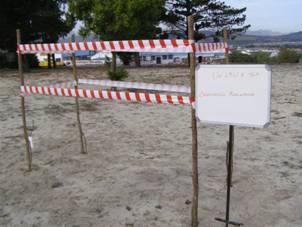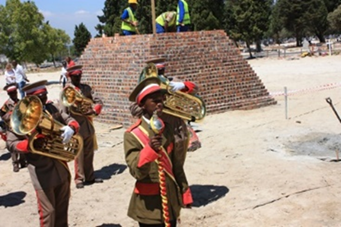In a 1947 letter to the Cape Town Clerk, the secretary of the Board of Trustees to the Cape Peninsula Cemeteries requested the establishment of a new cemetery in Stikland, Cape Town. Later that year, the Cape Times reported that the new cemetery will provide adequate burial ground to accommodate the Cape Peninsula’s dead for about the next 200 years. The cemetery was estimated to be ready for use by October with lush trees and flowering shrubs as well as 10 different allotments each sub-divided into 46 plots and 312 graves accompanying it. However, it would seem as if Stikland is no stranger to vandalism and damage. In 1977, a number of gravestones had been vandalized in the cemetery. By 23 October 2002, issues such as uncut grass, skew gravestones and broken photographs still characterized the condition of the graveyard. However, the environmental conditions since 2002 indicate a turn to revamping the cemetery. These improvements were said to take place through employing more cleaning staff. The City Parks Department which runs 40 cemeteries in Cape Town, including Stikland Cemetery has contributed to the revamp and played a key role in establishment of a memorial to former liberation struggle veterans.
In celebrating its 15 years declaration as a world heritage site, the Robben Island Museum(RIM) embarked on a research project to commemorate those who died during incarceration on Robben Island. The enquiry into the deaths started in 1997 through interviews with ex political prisoners. These interviews give insight into the conditions ofthe prison as well as provided names of individuals who died while serving out their sentences. In 2008, the RIM was contacted by the Mvalwana family who were enquiring about the death and burial of their father and grandfather, Zincwasile Mvalwana, a former Robben Island Prisoner. The grandson of Mvalwana, at a young age, had been told by one of the family’s elders that his grandfather had been buried Stikland Cemetery. The Museum’s Research Unit, in collaboration with the National Prosecuting Authority (NPA), corresponded with the City of Cape Town a year later to request permission to explore their burial registers in an attempt to locate Zincwasile Mvalwana as well as other prisoners who may have been buried alongside him. During their search, they discovered the names of Zincwasile Mvalwana and eleven other prisoners namely: Jimmy Simon, Mountain Langben, Lameki Kula, Mlungisi Mqalu, Frank Mani, Rueben Laiwa, Solomon Makisi, Matinise Batyi, Sipho Klhalipha, John Poni and Charlie Mkele in the Stikland Cemetery burial registers.The prisoners were arrested during the 1960s and sent to Robben Island during 1962 and 1963. Due to apartheid laws and regulations, the remains of the prisoners who died during incarceration on the Island, their remains had not been sent home and no records were kept about their death and burials. Thus, these men were buried as paupers leaving families without a clue about their remains for over 40 years.

Following the discovery, relatives of the deceased prisoners were informed by the RIM about the location of the graves at Stikland Cemetery. The relatives then requested the bodies exhumed in order to provide a dignified burial to their loved ones. Shortly after, the representatives of the families were invited to a pilgrimage to Robben Island as well as to Stikland Cemetery in order to reconnect with the deceased. These visits took place between 2009 and 2010. In 2010, the National Prosecuting Authorities (NPA) Missing Persons Task Team(MPTT) sent an application to the South African Heritage Resources Agency (SAHRA) to exhume at Stikland. The MPTT was established around 2005 and their focus was on ‘tracing’, ‘exhuming’ and ‘identifying’ the bodies of the remaining missing person’s cases submitted to the Truth and Reconciliation Commission (TRC). The undertaking of exhumations at the Stikland Cemetery in the hopes of locating the remains of the twelve former Robben Island prisoners fell into the framework of the MPTT.
Due to the lack of a layout plan, City Parks was requested to determine the approximate position of the graves at Stikland Cemetery. Following this, three excavations on site began.However, despite extensive digging, the archaeologists reported that they were unable to successfully locate and positively identify any of the remains for exhumation purposes. Therefore the remains that were uncovered at Stikland Cemetery did not match any of the prisoners. However, the MPTT had managed to positively locate some of the prisoners’ remains but this too had certain complications. This is evident in the case of Siyeta Simon, whereby the MPTT was sure where his remains were but could not exhume as there were two other bodies buried on top of him. In February 2011, the NPA’s MPTT informed families that they would end the exhumation process. The news was not received well as many families had hoped to finally rebury their loved ones close to their homes and give them a dignified burial.

Intensiveconsultations, between the relevant parties, took place in an attempt to decide on an alternative approach to restore the dignity of those who passed on. It was decided that the best way to pay homage to the prisoners was through spiritual reparation and the erection of a memorial. The conceptual design and layout of the memorial was decided upon by the RIM and was based on the design at the Mamelodi Cemetery which commemorated Pan Africanist Congress’s (PAC) members who were executed during apartheid. The pyramid design has both African and Egyptian roots andconnections. Thus it was best suited for the architectural design of the memorial. In addition to this, the City Parks has declared that no further burials will take place in the vicinity where the prisoners were buried. The memorial was unveiled on the 21March 2013, alongside the names of the 12 political prisoners. After a 40 year wait, the families of the deceased had finally been able to gain some closure.
Bosman, P., ‘Vernielde grafte pla’, Die Burger.23 October 2003.
Cape Times., ‘Sufficient Graves for 200 Years’, Roeland Street Archives. 14 July 1947.
City of Cape Town. (2013), ‘Memorial to be built in Stikland Cemetery for Robben Island political prisoners’, Available Online: www.capetown.gov.za/en/Pages/MemorialbuiltStiklandCemeteryRobbenIsland.aspx [Accessed: 15 May 2019].
Die Burger., ‘Grafsteen-vandalisme: Publiek moet opdok’, 30 November 1977.
Jassiem-Marcus, N. (2013), ‘Memorial for missing prisoners’, Available Online: www.iol.co.za/the-star/memorial-for-missing-prisoners-1470251 [Accessed: 15 May 2019].
Letter from Board of Trustees of the Cape Peninsula Cemeteries Secretary to the Town Clerk, ‘Establishment of New Cemetery at Stikland’, Municipality of Bellville. 17 May 1947.
Phaliso, S. (2009), ‘Forgotten for 40 years, pauper graves of 1960s Island prisoners uncovered’, Available Online: westcapenews.com/?p=836 [Accessed: 15 May 2019].
Rassool, C., ‘Human Remains: Disciplines of the Dead and the South African Memorial Complex’ in D.R. Petersen, K. Guava and C. Rassool, the Politics of Heritage in Africa: Economies, Histories, Infrastructures (Cambridge University Press, 2015), 140.
Tongo-Cetywayo, N. (2014), ‘Restoring Dignity to the 12 Political Prisoners who died During Incarceration at Robben Island’, Robben Island Museum: Department of Arts and Culture.